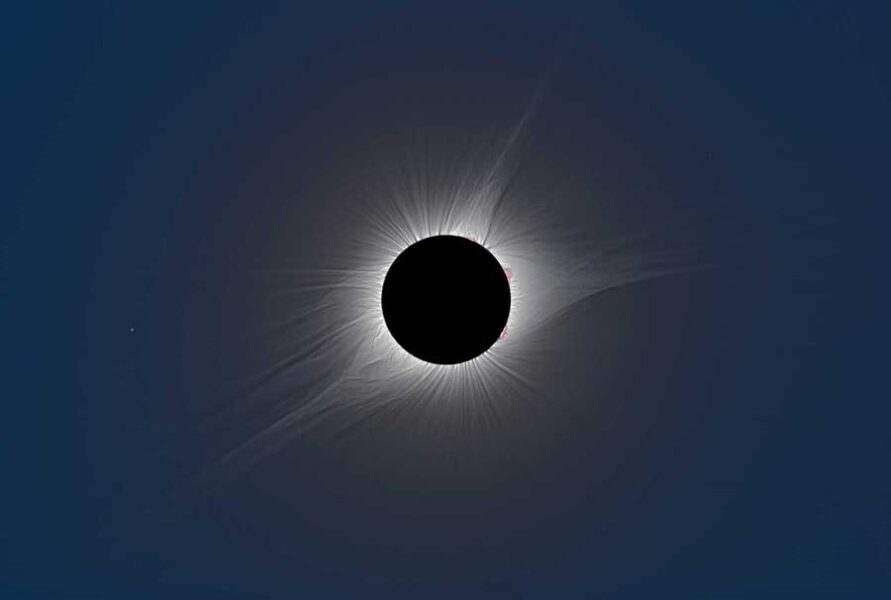A long totality passing through Mexico, the U.S., and Canada beckons — and planning ahead will be crucial.

Photo by Rick Fienberg, processing by Sean Walker; courtesy TravelQuest International and Sky & Telescope
To witness a total solar eclipse is to see the outer edges of our star as they truly are, as the spiky and spellbinding corona becomes visible to the unaided eye during a few chilled minutes of twilight.
Totality will come to Mexico, the U.S., and Canada on Monday, April 8, 2024, and it’s coming less than seven years after the last eclipse to cross North American soil, on August 21, 2017. For many, the 2024 event will be the most impressive total solar eclipse of their lives.
The Path of Totality on April 8, 2024

More than 30 million people live in the path of totality, almost three times more than for the 2017 eclipse.
The maximum possible totality available to eclipse-chasers on April 8, 2024, will be 4 minutes 28 seconds in Nazas, Mexico, but the Moon blocks the Sun only a second less as the path enters Texas. Maximum totality gradually lessens as the path heads northeast, reducing to 2 minutes 52 seconds as it leaves Canada for the Atlantic Ocean.
About 10,000 miles long, the path starts close to Penrhyn Atoll in the Cook Islands in the South Pacific Ocean. It touches Islas Marías (Mary Islands) just before reaching land at Mazatlán in Sinaloa, Mexico. The Moon’s shadow then engulfs Torreón and Durango before entering the U.S., where it will cross 15 states: Texas, Oklahoma, Arkansas, Missouri, Illinois, Kentucky (as well as tiny regions of Tennessee and Michigan), Indiana, Ohio Pennsylvania, New York, Vermont, New Hampshire, and Maine. It enters Canada over Lake Eerie, bringing totality to Ontario, Quebec, New Brunswick, Prince Edward Island, and Newfoundland. Visit eclipse2024.org for simulations of exactly what observers will see from thousands of locations.
Subscribers to Sky & Telescope can find a detailed rundown of the weather prospects and other planning aspects for all of these locations in the April 2023 issue.
Weather Prospects on April 8, 2024

If there’s one huge difference between the 2017 and 2024 total solar eclipses, it’s the weather. April is an unpredictable month, and it’s even tornado season in the American Midwest. It’s also important to remember that clouds can form as the temperature drops by as much as 15ºF before an eclipse.
According to long-time eclipse meteorologist Jay Anderson at eclipsophile.com, locations with the best prospects for clear weather are all in Mexico. Mazatlán on the coast has a 28% chance of clouds on eclipse day followed by Torreón (27%) and Durango (30%) inland in the mountains. In the U.S. the most likely place to have clear skies is Texas Hill Country, with Fredericksburg (49%) and Kerrville (50%) in prime position, though Junction (44%) close to the northern edge of the path has a slightly higher chance of a clear sky.
“Eclipse-chasers study the weather starting several days in advance and are prepared to drive several hundred miles to maximize the odds,” says Michael Zeiler, a Santa Fe, New Mexico-based cartographer and eclipse-chaser who runs GreatAmericanEclipse.com. Just prior to an eclipse, Anderson usually swaps from long-term climatological forecasts to all-important short-term updates on the weather, both on Sky & Telescope and on eclipsophile.com.
Traffic prospects on April 8, 2024

Anyone who watched the eclipse in 2017 and drove home that night will remember the horrendous traffic. “On the morning of the eclipse, the traffic usually isn't too bad,” says Zeiler, although he advises getting into position a day early. “It’s after the eclipse that it’s terrible because everyone gets on the highway at the same time.” Learn from 2017 and plan to stay an extra night.
Booking Accommodation and Tours
Scores of eclipse tours are already sold out, including Sky & Telescope’s The Great Texas Eclipse Tour (although there’s a waiting list). However, S&T’s Mexico Eclipse Cruise still has spots available.
Visit any popular hotel-booking website, and you’ll find that lodging opportunities in many cities in or near the path of totality are either booked up or charging exorbitant prices. “A lot of places that are asking for very high prices won't realize them,” says Zeiler. "If they don't fill up, then they’ll release them at reasonable prices.” So expect massive price reductions as the eclipse comes closer.
If the 2017 eclipse is anything to go by, we can also expect many campsites and RV parks to open for booking in the coming months. Some good resources for checking the latest public events and viewing parties include National Eclipse as well as Sky & Telescope's Events calendar.

There are already lodgings beyond the edge of the path of totality that are offering “99% totality” — but that doesn’t exist. “They mean a 99% partial solar eclipse; 99% and 100% are enormously different from a viewing standpoint, you're either in totality or you're not,” says Fred Espenak, a retired NASA astrophysicist, author, photographer and eclipse expert known as Mr. Eclipse. “But for people who don't know anything about eclipses and have never seen one before, a 99% partial solar eclipse will be incredibly spectacular and amazing — they won't know what they've missed.”
What they’ll miss is an event that won’t be surpassed in North America until a maximum 6 minutes and 6 seconds of totality in Florida on August 12, 2045.
Jamie Carter is the Editor of WhenIsTheNextEclipse.com and author of The Complete Guide To The Great North American Eclipse of April 8, 2024.
 1
1








Comments
Randy Pfeiffer
April 9, 2023 at 9:44 am
Lake Eerie?
You must be logged in to post a comment.
You must be logged in to post a comment.